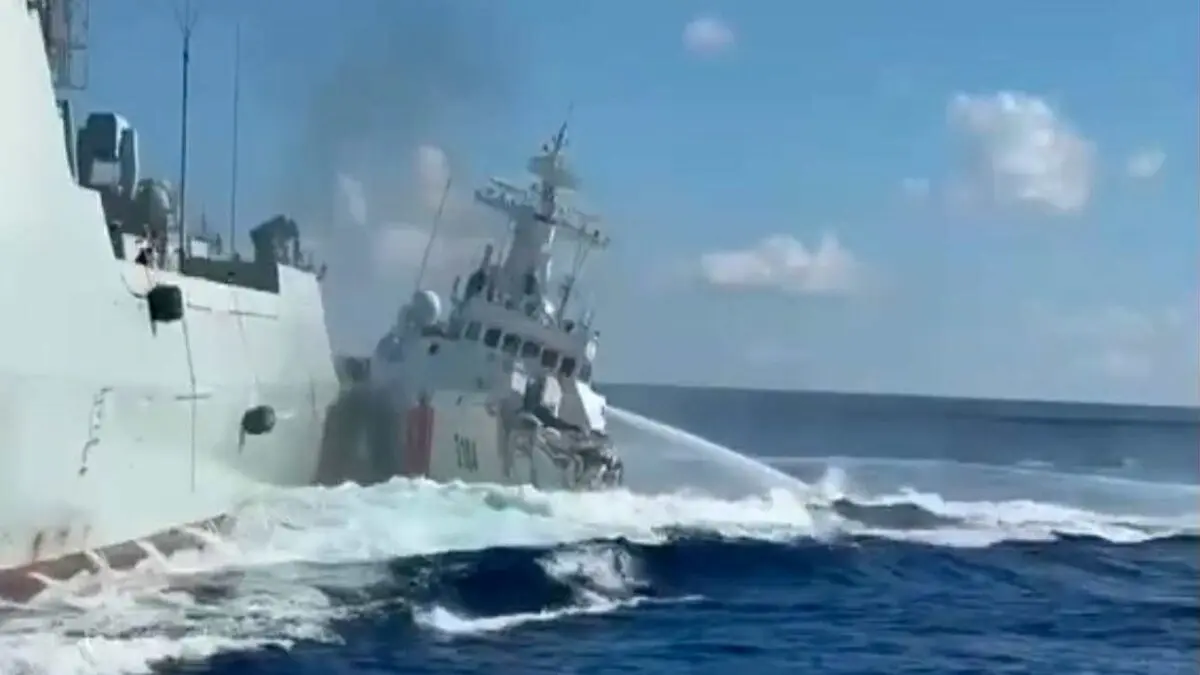“(Manila/Beijing — August 11, 2025) – Two Chinese ships appear to have collided while pursuing a Philippine boat near a disputed site in the South China Sea, according to initial reports from Philippine maritime officials and local media. DefenseScope has not independently verified the photos or claims from either side, and both governments were still gathering official statements at the time of publication.
- (Philippine Coast Guard/The Sun)
What is known so far
Initial reports describe a Chinese ship attempting to intercept a smaller Philippine vessel when it made a sharp turn that resulted in contact with another approaching Chinese ship. The incident occurred simultaneously. The collision The shadowing, water-cannoning and obstruction maneuvers are said to have become routine. Around resupply and patrol missions in the disputed waters. Initial reports indicated no immediate serious injuries, although minor hull damage is alleged.
- The bow section of the Chinese coast guard vessel was damaged after the incident. (IDU)
Official responses and competing stories
Philippine officials said they were collecting position data, radio recordings and video to document the sequence of events. In past interviews, Manila has released footage to support its claims of unprotected obstructions and friction. Beijing generally claims its coast guard and navy operate legally within Chinese jurisdiction. , and it repeatedly accuses the Philippines of “provocation” and “illegal intrusion.”
Given the sensitivity, expect different official statements: Manila could call the collision the product of unsafe Chinese maneuvers, and Beijing could present it as an inevitable consequence of Philippine activity in the waters, as China claims.
Why this matters
Even when a ship does not collide intentionally, complex close-in maneuvers in heavy traffic and shallow waters carry a constant risk of miscalculation. The collision between two Chinese ships during the blockade attempt underscores three dynamics that now shape the South China Sea:
- Narrow space of operations: Disputed rocks and shoals concentrate Coast Guard, Navy, Army, and fishing vessels into small areas, leaving little margin for error
- Escalatory signaling: Water cannons, blocked runs, and flares have become routine, increasing the likelihood that false readings or mechanical failure could lead to an accident.
- Information warfare: The rapid release (or selective withholding) of video and AIS tracks before a formal investigation is complete shapes international perception.
- The second ship involved in the incident was a Type 052D destroyer, Hull No. 164, named Guilin. (IDU)
Legal and strategic context
A 2016 arbitration tribunal ruling under UNCLOS rejected China’s legal basis for the “nine-dash line”, but Beijing does not recognize the decision and has Guard and a broader maritime service. The military continues to enforce local regulations in the disputed waters. Manila, backed by growing support from treaty ally the United States and regional and European partners, maintains that its resupply and patrol missions are legitimate in its exclusive economic zone.
The clash — especially the one captured on video — could further strain diplomatic relations and spur new operational rules from both sides, including tighter escorts, stronger hulls for smaller vessels, or improved tactics around ramming-risk encounters.
Risk escalation
The incident was triggered by joint exercises by U.S. and allied navies and increased Coast Guard regulations. Neither side wants a direct naval clash; however, the additional ladder is very difficult:
- Minor collision or damage to equipment →
- Injured crew →
- Incapacitated Use of force (e.g., targeted water cannons on bridges/sensors) →
- Introduction of armed escorts and warning shots →
- Emergencies requiring third-party mediation or alliance consultations
Today’s reported clashes fit into the lower tier, but if operational patterns do not change they pose a higher risk of second and third tiers.
What to watch for next
- Verified evidence: Release of synchronized video, photos, and AIS/ADS-B tracks will clarify the geometry and timing of the maneuver.
- Language in official statements: References to “dangerous” or “hostile” acts, or demands for compensation, will signal how hard each side intends to press its case.
- Operational adjustments: Manila will consider tighter escort profiles on sensitive runs and expects Beijing to refine its intercept tactics to reduce blue-on-blue risk while maintaining pressure.
- Diplomatic engagement: Any hotline use, verbal notes, or statements from ASEAN partners and extra-regional stakeholders (U.S., Japan, Australia, EU) indicate whether this incident is heading for a broader diplomatic test.
Bottom Line
The apparent collision between two Chinese ships while pursuing a Philippine boat is a reminder that force can escalate unexpectedly in the near term. Even without casualties, such incidents can complicate political narratives and invite sharp reactions at sea. The stability of the region now depends on whether operational discipline and transparent evidence can prevent dangerous encounters from becoming the next crisis.”
Read More: Canada’s Armed Forces in Transition: Strategic Imperatives and Capabilities for the 2030s
FAQs: People Also Ask
Two Chinese ships collided while chasing a Philippine boat near the disputed area. According to reports, one Chinese ship suddenly overturned and accidentally collided with another Chinese ship. Damage was minor, and no serious injuries were reported.
The collision shows how dangerous close encounters have become in the South China Sea. With so many ships operating in small areas, even routine maneuvers like blocking or water-cannoning can lead to accidents that could escalate regional tensions.
Philippine officials are collecting videos, radio logs and situational data to support their claims. They often call Chinese actions unsafe. China, on the other hand, generally says its ships operate legally in its waters and blames the Philippines for “provocations.”
For now, the clash is being viewed as a minor incident. But experts warn that repeated clashes, injuries or damage could force both countries to bring in armed escorts, fire warning shots or seek help from allies like the United States, raising the risk of escalating tensions.








Leave a Reply